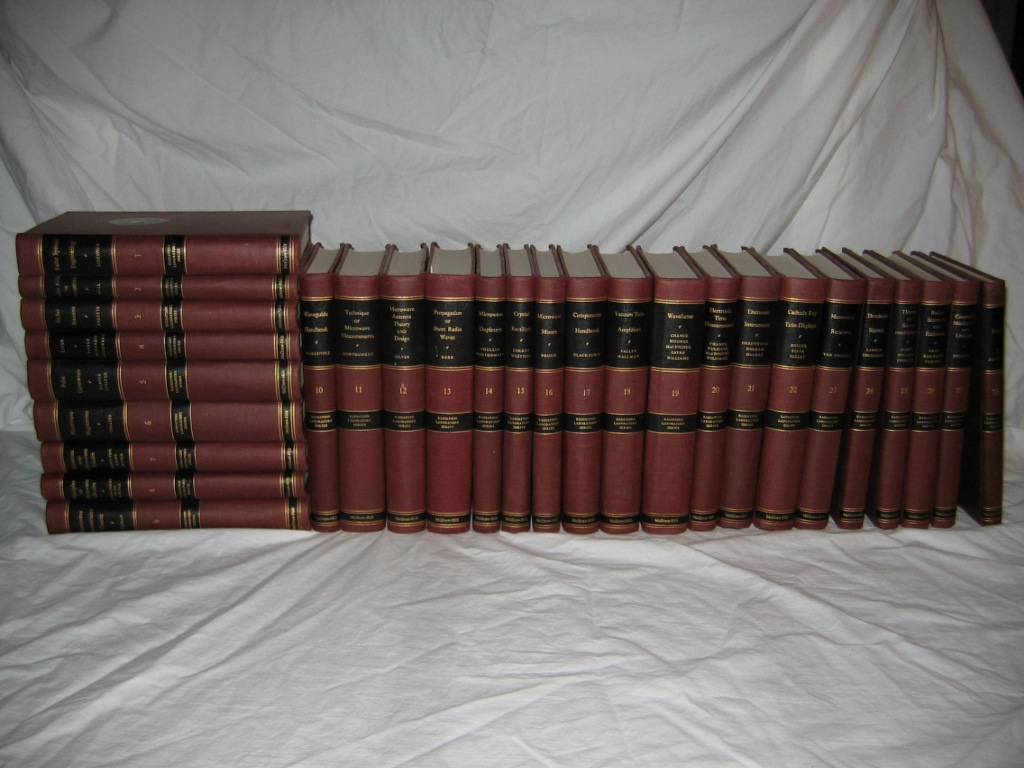
The MIT Rad Lab Series
After the end of World War II, the United States government continued to
pay key people who had worked at the Radiation Laboratory for six months
to enable them to write about their work. From the forward of each book:
The tremendous research and development effort that went into the
development of radar and related techniques during World War II resulted
not only in hundreds of radar sets for military (and some for possible
peacetime) use but also in a great body of information and new
techniques in the electronics and high-frequency fields. Because this
basic material may be of great value to science and engineering, it
seemed most important to publish it as soon as security permitted.
However, an altruistic drive to publish the Lab's achievements in open
literature was not the only impetus. As C. C. Bissell observes:
The imposing 27-volume [sic] Radiation Lab Series was not only a
technological statement, but also a political statement about the role
the United States was to play in the post-war world... that in the
post-war world the United States would be the intellectual driving force
of science and technology, as well as the economic and political
super power. [1]
The most interesting volumes to control engineers are volumes 21 and 25.
The twenty-eight volumes are:
- Louis N. Ridenour.
Radar System Engineering, volume 1 of MIT Radiation
Laboratory Series.
McGraw-Hill, New York, 1947.
- John S. Hall.
Radar Aids to Navigation, volume 2 of MIT Radiation
Laboratory Series.
McGraw-Hill, New York, 1947.
- Arthur Roberts.
Radar Beacons, volume 3 of MIT Radiation Laboratory
Series.
McGraw-Hill, New York, 1947.
- J. A. Pierce, A. A. McKenzie, and R. H. Woodward.
Loran, volume 4 of MIT Radiation Laboratory Series.
McGraw-Hill, New York, 1948.
- G. N. Glasoe and J. V. Lebacqz.
Pulse Generators, volume 5 of MIT Radiation Laboratory
Series.
McGraw-Hill, New York, 1948.
- George B. Collins.
Microwave Magnetrons, volume 6 of MIT Radiation Laboratory
Series.
McGraw-Hill, New York, 1948.
- Donald R. Hamilton, Julian K. Knipp, and J. B. Horner Kuper.
Klystrons and Microwave Triodes, volume 7 of MIT Radiation
Laboratory Series.
McGraw-Hill, New York, 1948.
- C. G. Montgomery, R. H. Dicke, and E. M. Purcell.
Principles of Microwave Circuits, volume 8 of MIT
Radiation Laboratory Series.
McGraw-Hill, New York, 1948.
- George L. Ragan.
Microwave Transmission Circuits, volume 9 of MIT Radiation
Laboratory Series.
McGraw-Hill, New York, 1948.
- N. Marcuvitz.
Waveguide Handbook, volume 10 of MIT Radiation Laboratory
Series.
McGraw-Hill, New York, 1951.
- Carol G. Montgomery.
Technique of Microwave Measurements, volume 11 of MIT
Radiation Laboratory Series.
McGraw-Hill, New York, 1947.
- Samuel Silver.
Microwave Antenna Theory and Design, volume 12 of MIT
Radiation Laboratory Series.
McGraw-Hill, New York, 1949.
- Donald E. Kerr.
Propagation of Short Radio Waves, volume 13 of MIT
Radiation Laboratory Series.
McGraw-Hill, New York, 1951.
- Louis D. Smullin and Carol G. Montgomery.
Microwave Duplexers, volume 14 of MIT Radiation Laboratory
Series.
McGraw-Hill, New York, 1948.
- Henry C. Torrey and Charles A. Whitmer.
Crystal Rectifiers, volume 15 of MIT Radiation Laboratory
Series.
McGraw-Hill, New York, 1948.
- Robert V. Pound.
Microwave Mixers, volume 16 of MIT Radiation Laboratory
Series.
McGraw-Hill, New York, 1948.
- John F. Blackburn.
Components Handbook, volume 17 of MIT Radiation Laboratory
Series.
McGraw-Hill, New York, 1949.
- George E. Valley, Jr. and Henry Wallman.
Vacuum Tube Amplifiers, volume 18 of MIT Radiation
Laboratory Series.
McGraw-Hill, New York, 1948.
- Britton Chance, Vernon Hughes, Edward F. MacNichol, Jr., David Sayre, and
Frederic C. Williams.
Waveforms, volume 19 of MIT Radiation Laboratory Series.
McGraw-Hill, New York, 1949.
- Britton Chance, Robert I. Hulsizer, Edward F. MacNichol, Jr., and Frederic C.
Williams.
Electronic Time Measurements, volume 20 of MIT Radiation
Laboratory Series.
McGraw-Hill, New York, 1949.
- Ivan A. Greenwood, Jr., J. Vance Holdam, Jr., and Duncan MacRae, Jr.
Electronic Instruments, volume 21 of MIT Radiation
Laboratory Series.
McGraw-Hill, New York, 1948.
- Theodore Soller, Merle A. Star, and George E. Valley, Jr.
Cathode Ray Tube Displays, volume 22 of MIT Radiation
Laboratory Series.
McGraw-Hill, New York, 1948.
- S. N. Van Voorhis.
Microwave Receivers, volume 23 of MIT Radiation Laboratory
Series.
McGraw-Hill, New York, 1948.
- James L. Lawson and George E. Uhlenbeck.
Threshold Signals, volume 24 of MIT Radiation Laboratory
Series.
McGraw-Hill, New York, 1950.
- Hubert M. James, Nathaniel B. Nichols, and Ralph S. Phillips.
Theory of Servomechanisms, volume 25 of MIT Radiation
Laboratory Series.
McGraw-Hill, New York, 1947.
- W. M. Cady, M. B. Karelitz, and Louis A. Turner.
Radar Scanners and Radomes, volume 26 of MIT Radiation
Laboratory Series.
McGraw-Hill, New York, 1948.
- Antonin Svoboda.
Computing Mechanisms and Linkages, volume 27 of MIT
Radiation Laboratory Series.
McGraw-Hill, New York, 1948.
- Keith Henney, editor.
Index, volume 28 of MIT Radiation Laboratory Series.
McGraw-Hill, New York, 1953.
One final word about the final volume of the series. The comprehensive
index suffers from an unfortunate decision made by the editor: proper
names, both author's names and laboratory names, were left out of the
combined index. While much of the science and engineering still holds
up fifty years later, present day technology archaeologists (such as this
author) are often more interested in looking up the individual
contributions made by some of the well-known personalities, such as Hall
and Nichols.
This author appreciates the difficulty in producing a consistent index
for a single book, much less a whole series. Nonetheless, Volume 28
would be monumentally more useful if it were possible to look up every
mention of the name `"Nyquist."
References
[1] C. C. Bissell. "Textbooks and subtexts."
IEEE Control Systems Magazine.
pages 17-25, June 1996.
Kent H Lundberg
November 2002
